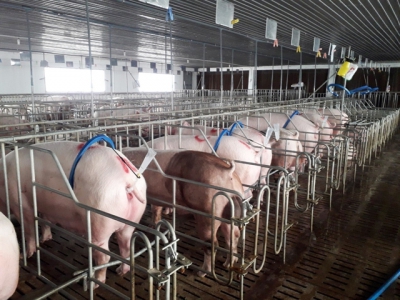Disease-free zones key to exporting animal products

HÀ NỘI — Forming more disease-free farming zones is seen as critical to exporting livestock products as few such zones in Việt Nam meet the World Organisation for Animal Health (OIE) standards.
Pig breeding area of Hương Vĩnh Cửu Co Ltd in Đồng Nai Province. Việt Nam exported 2,150 tonnes of meat and related products worth US$6.95 million in April. — VNA/VNS Photo Minh Hưng
The country exported 2,150 tonnes of meat and related products worth US$6.95 million in April, up 27.1 per cent in volume and 3.7 per cent in value compared to March, with Hong Kong (China), mainland China, and Thailand among the main destinations, data from the General Department of Việt Nam Customs showed.
The Công Thương (Industry & Trade) newspaper cited Nguyễn Văn Long, Deputy Director of the Department of Animal Health at the Ministry of Agriculture and Rural Development, as saying Việt Nam must comply with international regulations to export animal products, including those set by the World Trade Organisation (WTO) and the OIE.
Exports of animals and related products can only come from countries and territories that have farming establishments and zones free of disease and ensure biological safety.
As of May, Việt Nam had 2,288 closed farming establishments and zones but these only satisfy Vietnamese standards, with none meeting OIE requirements, Long pointed out.
He added that as outbreaks of dangerous disease are spreading, many countries have set up strict requirements on imported fresh products. Meanwhile, Việt Nam faces difficulties in organising safe animal farming, especially in terms of disease control, monitoring of farming zones, and grassroots safety chains.
Recently, authorities have stepped up negotiations on animal product exports with some countries, Long said, noting that to secure smooth exports the most important issue is that such products hail from disease-free zones meeting OIE rules.
To do this, it is first necessary to exert sound control over disease outbreaks and minimise the risk from animal diseases nationwide. A national programme for monitoring and certifying animal products should also be carried out to pave the way for exporting qualified products, he said.
There are 15 disease-free zones around the country at present, and co-ordination with localities is needed to help such zones under Vietnamese standards meet OIE requirements.
Long recommended cities and provinces devise plans to form and maintain disease-free animal farming zones while paying attention to animal husbandry.
Related news
 Bac Giang enjoys successful early-ripening lychee crop
Bac Giang enjoys successful early-ripening lychee crop The early-ripening lychee output this year accounted for nearly one-third of the province's total lychee production, about 58,000 out of 180,000 tonnes
 Vietnam May coffee exports down 1.4% m/m, rice down 19.9%
Vietnam May coffee exports down 1.4% m/m, rice down 19.9% Vietnam's coffee exports in May were down 1.4% from April at 130,285 tonnes, while rice exports in the same period fell 19.9% against the preceding month
 Vegetable and fruit exports hit $1.77 billion during Jan-May
Vegetable and fruit exports hit $1.77 billion during Jan-May Việt Nam’s export turnover of fruits and vegetables hit US$1.77 billion in the first five months of this year, a year-on-year increase of 18 per cent